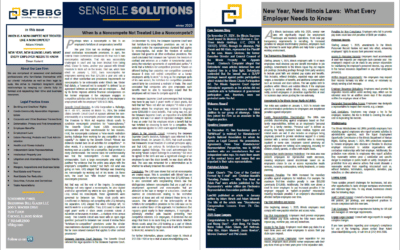Law school finals? The semester barely started. Yet it is never too early to begin constructing the contemporary law school final exam question.
Follow the tried‐and‐true law school exam question formula taken from classes mixing law and social policy. Begin with a hot topic, add some controversial complications, perhaps throw in a little unregulated Internet marketing, include the requisite state statute with outdated language and set up a counterintuitive result.
This formula may lead to, say, the same‐sex couple who, wanting a child together, places an ad on Craigslist. When “Wayne,” a potential sperm donor, answers the ad, “Jill” and her partner “Allison,” a committed couple from the state of Wigmore, present him with a contract downloaded from the Internet.
Unlike many Internet forms, this one proves relatively clear. All sign off that the donor will have neither the right nor the responsibility to raise any resulting children, including no custody or visitation rights, and specifically acknowledge that Wayne “will have no paternal rights that are traditionally vested in the biological father of a child.”
The couple then successfully inseminates Jill at the couple’s home without difficulty, leading to baby “Mary’s” birth. All seems well, so it’s time to add the exam question wrinkles.
Two months after Mary’s birth, Jill applies to the Wigmore Department of Children and Families (DCF) for food, cash and medical assistance for the baby. Jill identifies Mary’s father on the application as “donor.”
In response to this disclosure, the DCF requests a copy of the sperm donor contract. Reluctant to bring Wayne back into the family picture, Jill responds it is unavailable. In another DCF application 17 months later, she will amend the description of Mary’s father to “anonymous sperm donor.”
The DCF cuts off aid to Jill and Mary when it doesn’t receive the requested contract, forcing Jill to make it available. Upon seeing that all parties signed the contract and the donor is not actually anonymous, DCF asserts Wayne is on the hook for child support under Wigmore law. Now, the exam question is rolling.
Jill suddenly finds herself in court where DCF, seeking to have Wayne adjudicated as the father, has filed a petition to determine paternity. Although Jill, Allison and Wayne all agreed in their downloaded contract that Wayne would not be responsible for Mary’s upbringing, DCF relies on the Wigmore Parentage Act, which reads in part:
“The donor of semen provided to a licensed physician for use in artificial insemination of a woman, other than the donor’s wife, is treated in law as if he were not the birth father of a child thereby conceived.”
By failing to comply with the statutory requirement to donate semen only to a physician, the DCF argues, Jill, Allison and Wayne diverged from the only path provided by the Wigmore legislature for an artificial insemination procedure that vests all parties with legal protection from a later claim of paternity. The response argument is made that the parties entered into an unambiguous contract clearly indicating all parties’ intent that Wayne have no rights or responsibilities for Mary.
The irksome exam question might conclude by calling for consideration of how the court should rule on the DCF’s petition in light of the parties’ contract, the applicable statute and any relevant public policy concerns.
While these facts may make for an intriguing final exam, they are all too real. Simply substitute “Kansas” for “Wigmore.” This precise scenario was considered by the Shawnee County district court in Kansas ex rel. Secretary, Department for Children and Families v. W.M., No. 12 D 2686 (Jan. 22, 2014).
The court noted that the Uniform Parentage Act, on which Kansas’ parentage act is based, was modernized in 2000 and 2002 to clarify parentage issues involving children born from artificial insemination. Physician involvement may have been appropriate decades ago, but the 21st century version of the act recognized modern advances. Kansas, however, did not adopt the revisions “for reasons known only to the legislature.”
Stuck with an unambiguous state law dating to 1973, the year the Sears (now Willis) Tower was completed, Richard Nixon began his second term and the Miami Dolphins completed the NFL’s only perfect season, the court had no choice but to uphold its antiquated requirement that a physician participate in an artificial insemination for it to divest the donor of his parental responsibilities.
Under Kansas law, the court had to ignore the parties’ non‐paternity agreement, and in an apparent case of first impression, ruled the contract comprised an unauthorized attempt to circumvent Wayne’s parental obligations. Wayne’s status as the birth father was undiminished by the parties’ uncontested contractual agreement that he would not be held responsible for Mary.
The state’s interest in recovering the $6,000 in benefits it provided to Mary, as well as holding Wayne responsible for future child support obligations, was deemed paramount.
Interestingly, Wayne could have avoided liability in neighboring Oklahoma, where the modern version of the Uniform Parentage Act was adopted. Not so in Illinois, however. The Illinois Parentage Act, 750 ILCS 40/3, remains just as mired as the Kansas version in the world as it existed in 1973.
While legislation has been pending for one year in the Illinois House to repeal the current Illinois statute and replace it with a dramatically revamped approach, the proposed House Bill 1243 would surprisingly maintain this little‐noticed, but highly outdated, requirement that the semen donation be made to a licensed physician.
Whether this issue is considered by law students or judges, the dilemma surrounding Mary and her consenting, adult parents in Kansas (and Illinois) proves quite contrary to basic fairness principles and evolving views of families.
Forcing child support obligations upon a sperm donor who all parties agreed would have no such responsibilities also vividly demonstrates the need for law to keep pace with the times.



